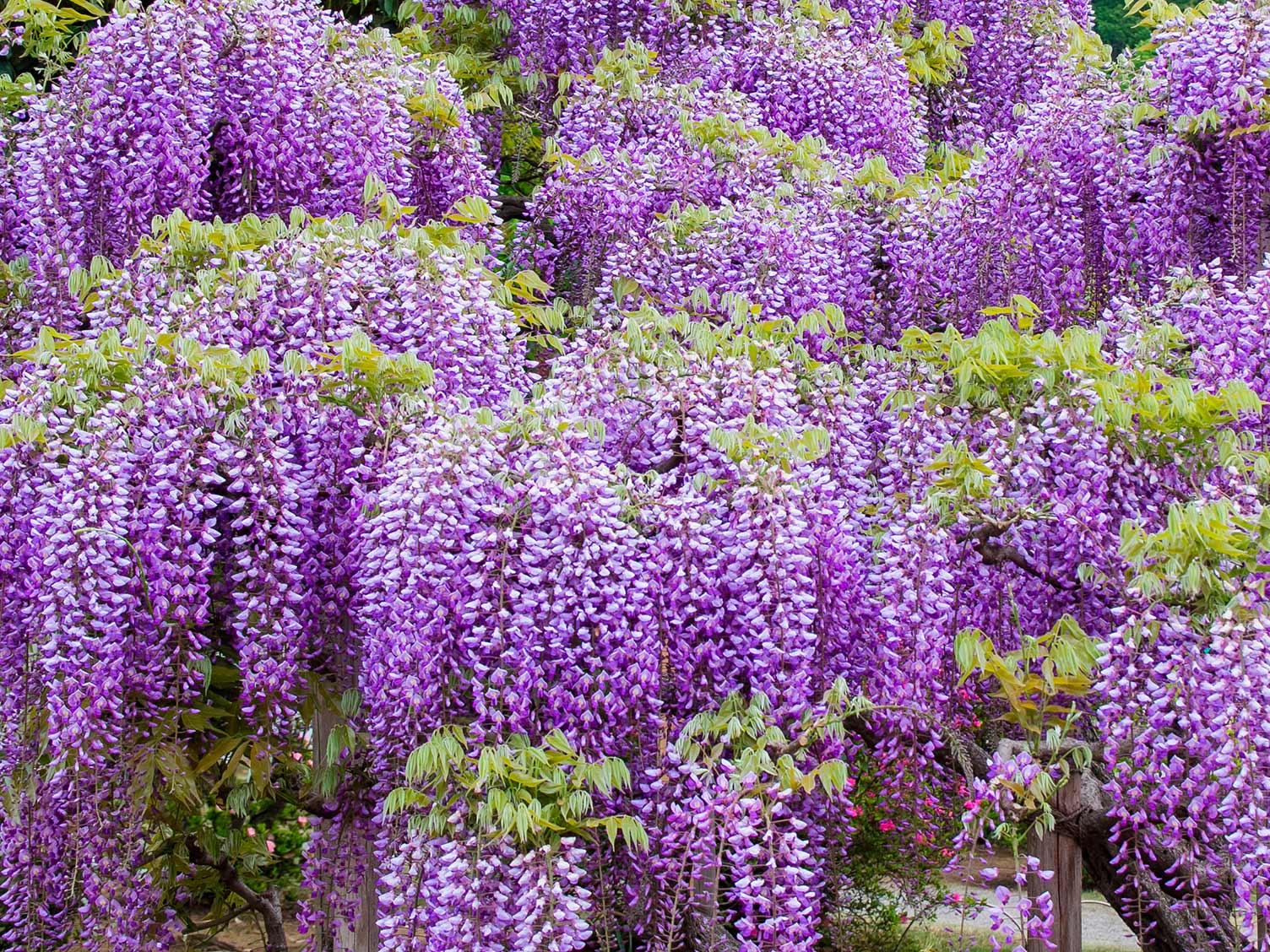Understanding the Life Cycle of Wisteria Vines
Wisteria, a flowering plant native to Asia, is renowned for its breathtaking beauty and captivating fragrance. With over 10 species, wisteria has become a popular choice for gardeners and horticulturists alike. To truly appreciate the wonders of wisteria, it’s essential to understand its life cycle, from germination to maturity. This knowledge is crucial for optimal care, as it allows gardeners to provide the necessary conditions for healthy growth and development. The life cycle of wisteria consists of several stages, including germination, seedling, sapling, and maturity. Understanding these stages is vital in answering the question, how long do wisteria take to grow? By grasping the different stages of growth, gardeners can tailor their care and attention to meet the specific needs of their wisteria plants, ultimately leading to healthier and more vibrant blooms.
Factors Affecting Wisteria Growth Rate: Climate, Soil, and More
Several factors influence the growth rate of wisteria, and understanding these factors is crucial for creating an ideal environment that fosters healthy development. Climate, soil type, sunlight, watering, and pruning are all critical components that can significantly impact the growth of wisteria. For instance, wisteria thrives in temperate climates with mild winters and warm summers, making it essential to choose a location that provides the right climate conditions. Similarly, soil type and quality play a vital role in wisteria growth, with well-draining soil and a pH between 6.0 and 7.0 being ideal. Adequate sunlight, typically between 6-8 hours, is also necessary for promoting healthy growth. Watering, too, is critical, with wisteria requiring consistent moisture, especially during the first year after planting. Pruning, another essential factor, helps control the growth of wisteria, promotes healthy development, and encourages blooming. By understanding and addressing these factors, gardeners can create an optimal environment that supports the growth of their wisteria plants, ultimately answering the question, how long do wisteria take to grow? By providing the right conditions, gardeners can expect their wisteria plants to thrive and bloom beautifully.
How to Plant Wisteria for Optimal Growth
Planting wisteria is a crucial step in its growth cycle, and doing it correctly can make all the difference in its future development. To ensure optimal growth, it’s essential to choose the right location, prepare the soil, and provide necessary support. When selecting a location, consider the climate, soil type, and available sunlight. Wisteria thrives in well-draining soil with a pH between 6.0 and 7.0, and full sun to partial shade. Before planting, prepare the soil by digging a hole twice as wide and just as deep as the root ball. Add organic matter such as compost or well-rotted manure to improve soil fertility and drainage. Gently remove the wisteria from its container, taking care not to disturb the roots. Place the plant in the hole, backfilling with soil and tamping it down gently as you go. Water thoroughly to settle the soil. Provide necessary support, such as a trellis or arbor, to help the wisteria grow upwards. By following these steps, gardeners can set their wisteria plants up for success, ultimately answering the question, how long do wisteria take to grow? With proper planting, wisteria can thrive and bloom beautifully, providing years of enjoyment.
The Role of Pruning in Shaping Wisteria Growth
Pruning is a crucial aspect of wisteria care, playing a vital role in controlling the growth of the plant, promoting healthy development, and encouraging blooming. By understanding the importance of pruning and implementing proper techniques, gardeners can shape the growth of their wisteria, ultimately influencing how long it takes to grow and thrive. Pruning helps to control the size and shape of the wisteria, encouraging a strong, sturdy structure that can support the weight of the plant’s beautiful blooms. It also promotes healthy growth by removing dead, diseased, or damaged wood, allowing the plant to focus its energy on producing new growth. Furthermore, pruning stimulates blooming by encouraging the formation of flower buds. To prune wisteria effectively, gardeners should prune in late winter or early spring, removing any dead or damaged wood and cutting back the previous year’s growth to encourage new shoots. By pruning regularly, gardeners can enjoy a healthy, thriving wisteria that blooms beautifully, providing years of enjoyment.
Wisteria Growth Stages: What to Expect and When
Wisteria plants go through several growth stages, from germination to maturity, and understanding these stages is crucial for providing optimal care. The first stage, germination, typically occurs within 1-3 weeks of planting, during which the seedling emerges from the soil. As the seedling grows, it develops its root system and produces its first set of leaves. This stage, known as the seedling stage, lasts around 1-2 months. Next, the wisteria enters the sapling stage, characterized by rapid growth and the development of a strong stem. During this stage, which can last up to 6 months, the wisteria can grow up to 10 feet tall. As the plant matures, it enters the adult stage, during which it produces flowers and continues to grow. This stage can last for many years, with some wisteria plants living up to 50 years or more. Understanding these growth stages is essential for providing the right care at the right time, ultimately influencing how long do wisteria take to grow. By knowing what to expect during each stage, gardeners can ensure their wisteria plants receive the necessary support and care to thrive.
Common Challenges and Solutions for Wisteria Growth
Despite their hardiness, wisteria plants can face various challenges that may hinder their growth. One common issue is pests, such as aphids, whiteflies, and spider mites, which can weaken the plant and reduce its growth rate. To combat pests, gardeners can use organic pest control methods, such as neem oil or insecticidal soap, and maintain good garden hygiene. Another challenge is diseases, like root rot and leaf spot, which can be caused by overwatering or poor air circulation. To prevent diseases, gardeners should ensure good drainage, avoid overwatering, and provide adequate air circulation around the plant. Nutrient deficiencies, particularly a lack of phosphorus, can also impact wisteria growth. Gardeners can address this by using a balanced fertilizer and following a regular fertilization schedule. By being aware of these common challenges and taking preventative measures, gardeners can ensure their wisteria plants receive the necessary care to thrive and reach their full potential, ultimately influencing how long do wisteria take to grow. Additionally, regular pruning, watering, and fertilization can help prevent these issues and promote healthy growth.
Maximizing Wisteria Blooms: Tips and Tricks
Wisteria plants are renowned for their stunning, fragrant blooms, which can be a highlight of any garden. To maximize wisteria blooms, it’s essential to provide the right conditions and care during the blooming phase. One crucial factor is sunlight, as wisteria plants require at least six hours of direct sunlight per day to produce abundant flowers. Additionally, wisteria plants benefit from regular watering, but it’s vital to avoid overwatering, which can lead to root rot and reduced blooming. Fertilization is also crucial, as wisteria plants require a balanced diet of nutrients to produce healthy flowers. A phosphorus-rich fertilizer can help promote blooming, and applying it in early spring can encourage more abundant flowers. Pruning is another critical aspect of maximizing wisteria blooms. By pruning the plant in late winter or early spring, gardeners can encourage the growth of new flowers and promote a fuller, more vibrant display. By following these tips and providing optimal care, gardeners can enjoy a longer and more spectacular blooming season, ultimately influencing how long do wisteria take to grow. With proper care and attention, wisteria plants can produce stunning blooms for years to come, making them a valuable addition to any garden.
Long-Term Wisteria Care: Maintenance and Upkeep
Once wisteria plants have reached maturity, it’s essential to maintain a regular care routine to ensure continued healthy growth and optimal blooming. One crucial aspect of long-term wisteria care is pruning, which should be done regularly to control the plant’s growth, promote healthy development, and encourage blooming. Pruning should be done in late winter or early spring, removing any dead or damaged wood and shaping the plant to maintain its desired form. Fertilization is another critical component of long-term wisteria care, as it provides the necessary nutrients for healthy growth and blooming. A balanced fertilizer should be applied in early spring, followed by a phosphorus-rich fertilizer in late spring to promote blooming. Pest management is also vital, as wisteria plants can be susceptible to pests like aphids, whiteflies, and spider mites. Regularly inspecting the plant and taking action to address any pest issues can help prevent infestations and ensure healthy growth. By following these tips and maintaining a regular care routine, gardeners can enjoy their wisteria plants for years to come, with optimal growth and blooming. With proper care and attention, wisteria plants can thrive, and understanding how long do wisteria take to grow can help gardeners plan and prepare for the different stages of growth. By incorporating these long-term care practices into their gardening routine, gardeners can enjoy the beauty and fragrance of wisteria blooms for years to come.






:max_bytes(150000):strip_icc()/chinese-wisteria-plants-2132898-05-9818f20d737140d18e457524086dcd98.jpg)


